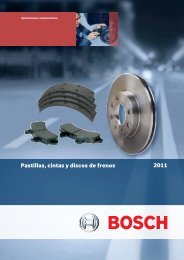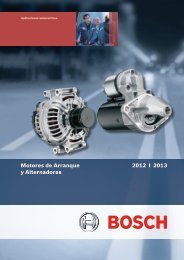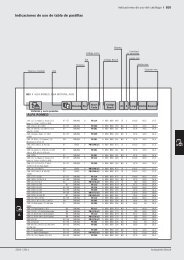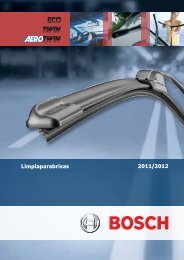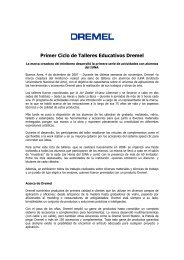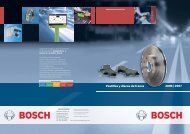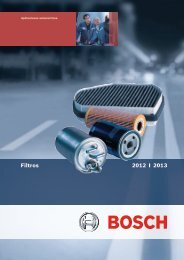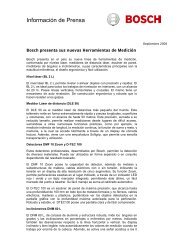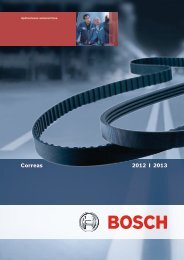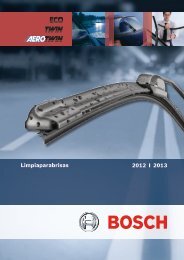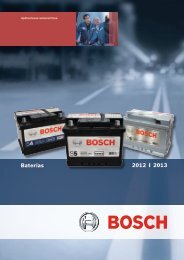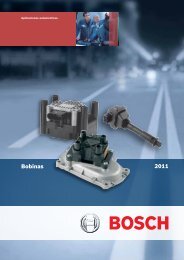Bosch Company History - Bosch Argentina
Bosch Company History - Bosch Argentina
Bosch Company History - Bosch Argentina
Create successful ePaper yourself
Turn your PDF publications into a flip-book with our unique Google optimized e-Paper software.
year in which <strong>Bosch</strong> reached its second major automotive milestone: the<br />
market launch of the <strong>Bosch</strong> automotive lighting system. With a generator,<br />
battery, and headlights, this was the first complete system from <strong>Bosch</strong> and<br />
laid the foundation for today's automotive on-board electrical systems.<br />
27.03.2007<br />
Page 3 of 8<br />
During this phase of the company's development, Robert <strong>Bosch</strong> began to<br />
donate money to charitable causes, including all the profits from the<br />
company's First World War armaments contracts. During the early 1920’s,<br />
and despite the severe inflation in Germany in 1923 with its crippling effects<br />
on the economy, the company rapidly overcame the consequences of the war,<br />
in particular the loss of many of its sales offices and factories outside<br />
Germany. By 1925, the network of sales offices outside Germany was larger<br />
than it had been before the outbreak of the First World War.<br />
3. New products, modernization, drafting of today's corporate<br />
constitution<br />
In the third phase of the company's history from around 1925 to 1960, new<br />
business units were founded covering areas outside the field of automotive<br />
technology, and the corporate constitution was redrafted. During this phase,<br />
Robert <strong>Bosch</strong> withdrew from the operational side of the business. In his last<br />
will and testament dated 1937, five years before his death in 1942, he laid the<br />
groundwork for the corporate constitution that is still valid today. This period,<br />
however, was also overshadowed by National Socialism and the Second<br />
World War. After the end of the war in 1945, the company again had to rebuild<br />
production and trading networks outside Germany and the production facilities<br />
that had been destroyed in Germany itself.<br />
In the mid-1920's, Robert <strong>Bosch</strong> restructured the company's board of<br />
management. This move was prompted by the dramatic effects of the 1926<br />
crisis in the European automobile industry that caused the company's sales<br />
(from 1917 to 1937 incorporated as "Robert <strong>Bosch</strong> AG") to drop by around 35<br />
percent between 1925 and 1926. Robert <strong>Bosch</strong> appointed a new<br />
management team comprising Hans Walz, Karl Martell Wild, and Hermann<br />
Fellmeth. He himself retired from the management of the company at the age<br />
of 65.<br />
Crisis and new products<br />
The new management felt it necessary to make radical cutbacks in personnel<br />
at all levels. Between 1926 and 1927, jobs were cut by over 25 percent. The<br />
crisis was quickly brought under control – to some extent thanks to the<br />
rationalization measures recently introduced, in particular the productionboosting<br />
assembly-line system launched in 1925. The company also started<br />
to diversify. <strong>Bosch</strong> began to concentrate on other product segments in order<br />
to reduce its unilateral dependence on the automotive industry.<br />
New business units such as Power Tools, Junkers Gasgeräte (manufacturers<br />
of natural gas-fired water heaters), Blaupunkt (radios for the car and the<br />
household), Fernseh GmbH (television studio equipment), Kinobauer (cinema<br />
projectors), and Household Appliances soon put the company back on an<br />
even keel. Key milestones of the restructuring included the first power tool



